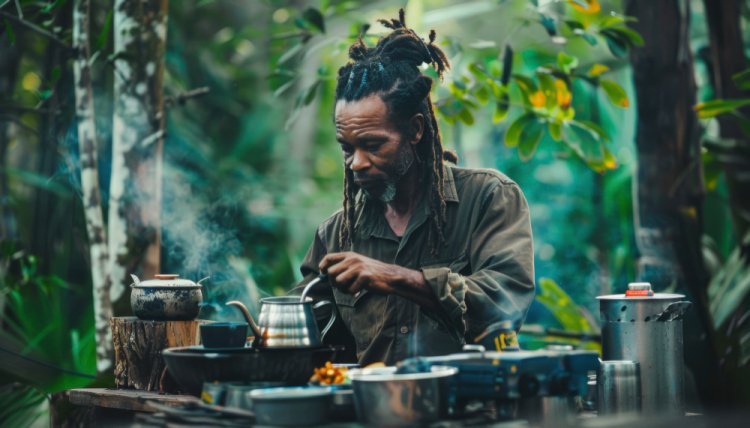Exotic Coffee from Zimbabwe
Zimbabwean Arabica was once famous not only throughout Africa

Zimbabwean Arabica was once famous not only throughout Africa, but was also actively purchased by European and American companies. After all the upheavals that have happened to the country over the past 40 years, local farmers have managed to maintain the old quality level, but supply volumes have fallen by tens and hundreds of times. Now we will talk about the coffee industry of Zimbabwe and its prospects - not long ago it became clear that the worst years seem to be behind us.
Coffee: The Road to Zimbabwe
Zimbabwe is located in the south of Africa, above South Africa, between the Zambezi River (in the north) and the famous Limpopo River (in the south). On the border of Zimbabwe with Zambia is one of the main African attractions - Victoria Falls.
Zimbabwe is landlocked and most of its territory is a plateau 1000–1500 m high. Until 1980, the country was under British rule and was called Southern Rhodesia. Like South Africa, it was once home to many white landowners who were successful in business, including coffee.
Coffee arrived in Zimbabwe at the end of the 19th century. They failed to turn the cultivation of beans into an industry the first time. The second time, in the 1920s, was no different. But the third attempt (1950s – early 1960s) was successful.
The civil war that unfolded in the country and the acquisition of independence (1980) did not hinder the development of the coffee sector for a long time. In 1989, 14.7 thousand tons of Arabica were harvested on an area of 5.8 thousand hectares. The yield per hectare was 2.3 tons. The result is impressive! In terms of quality, Zimbabwean coffee competed equally with Kenyan and Brazilian coffee. Subsequently, due to the devastation, farmers never managed to grow the same crop.
Types of Coffee from Zimbabwe
If in the 1970s Zimbabwe was considered one of the leading countries in Africa, then the crisis of 2000-2008 threw it into the sector of the poorest countries. A simple example: Zimbabwe used to export grain to neighboring countries, but in the 2000s it faced the need to buy it. In early 2013, the Minister of Finance of Zimbabwe said that after paying salaries to employees of state institutions, $217 (note: not thousands) remained in the treasury.
Zimbabwe mines gold, precious stones and various ores, grows tobacco, tea, sugar cane, cotton and coffee. The lack of access to the sea complicates the export of coffee. However, this is the least of the troubles. The harvest is often ruined by droughts. And most importantly, the land reform of 2000 left white farmers no choice but to leave. Government soldiers deliberately squeezed the English and Dutch out of their plots. The farms lost their owners. With them, jobs disappeared. And the new settlers simply did not know what to do with complex equipment or how to grow coffee at all.
Before 2000, there were about 180 medium and large farms (according to other sources - 120), several thousand small and a couple of powerful companies in Zimbabwe. By 2019, there were... 3 farms left cultivating coffee. In 2016, they grew 414 tons of coffee on 1,784 hectares, in 2017 - 500 tons on 2,225 hectares. They are not able to compete with other African countries. But they still maintain their reputation!
Since the mid-1990s, the following quality grades (in descending order) have been used to classify coffee in Zimbabwe:
- AAA (highest);
- AA;
- AB;
- PB (Peaberry);
- There are also other categories - they are used to mark damaged beans and other residues (used for instant coffee);
- The strange "Code 53" designation on bags of Zimbabwean coffee denotes top quality. Why "Code 53"? It's probably some kind of reference that only natives of the African country would understand.
The FAQ entry indicates "fair average quality", Plus - an intermediate level. For example, the Zimbabwe AA Plus Pezuru coffee is well-known, which is compared to the Brazilian Maragogype. Experts note a spicy bitterness in the taste. The Pezuru Estate has been producing this coffee since 1962.
AA Plus Pezuru, like AA Salimba (also with a "peppercorn"), is grown in the mountainous regions of Manicaland and Mashonaland provinces at an altitude of 1,100–1,300 m. They are located in the east of the country, on the border with Mozambique. Coffee plantations are located near the cities of Chipinge, Mutare, Chimanimani and in the Mutasa region. The local Arabica belongs to the Catimor and Caturra varieties. The coffee bushes are protected from the sun by the surrounding forests. The owners meticulously monitor the plots, promptly uprooting sick and old trees.
Prospects
Zimbabwean coffee
has managed to survive the hardest times of economic chaos. And for good reason – Nespresso has come to the aid of farmers. In September 2018, it launched a 5-year campaign aimed at improving the local coffee industry. As part of it, Nespresso will invest significant funds in the development of the industry and will train local landowners in the rules of coffee growing, while providing the necessary equipment.
Well, we hope that in the coming years, coffee from Zimbabwe will no longer be a rare guest at the table of lovers of strong drinks!
What's Your Reaction?















